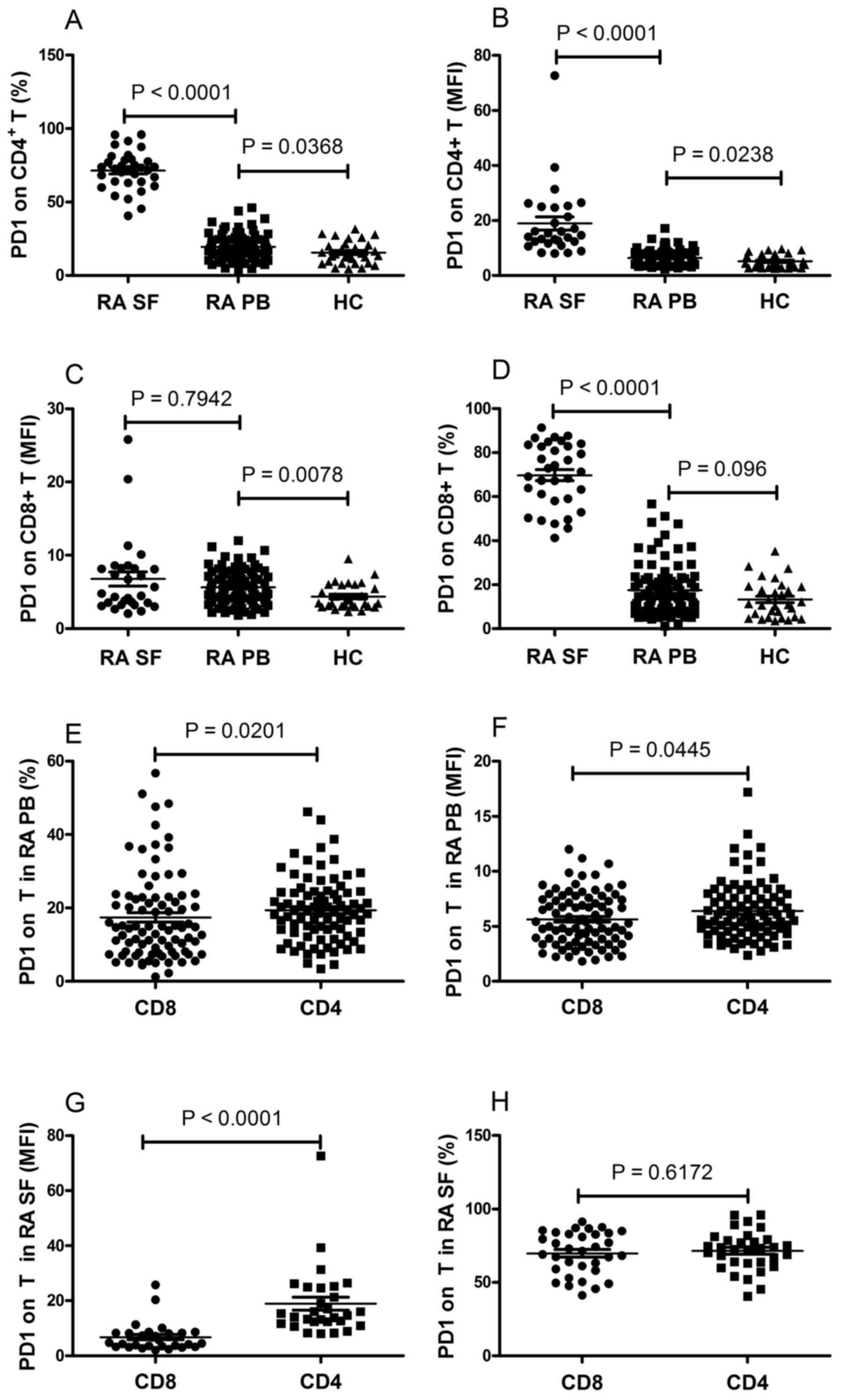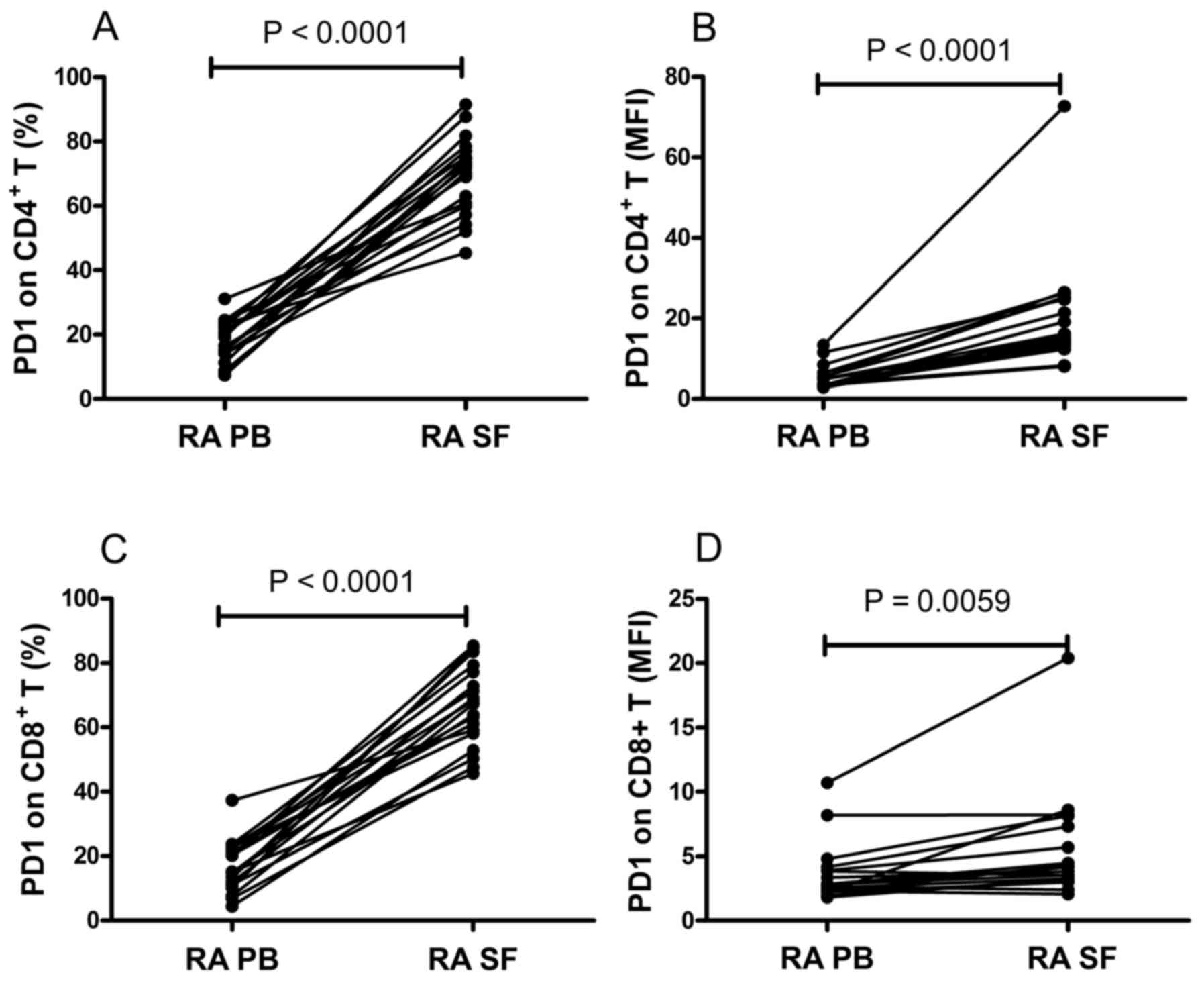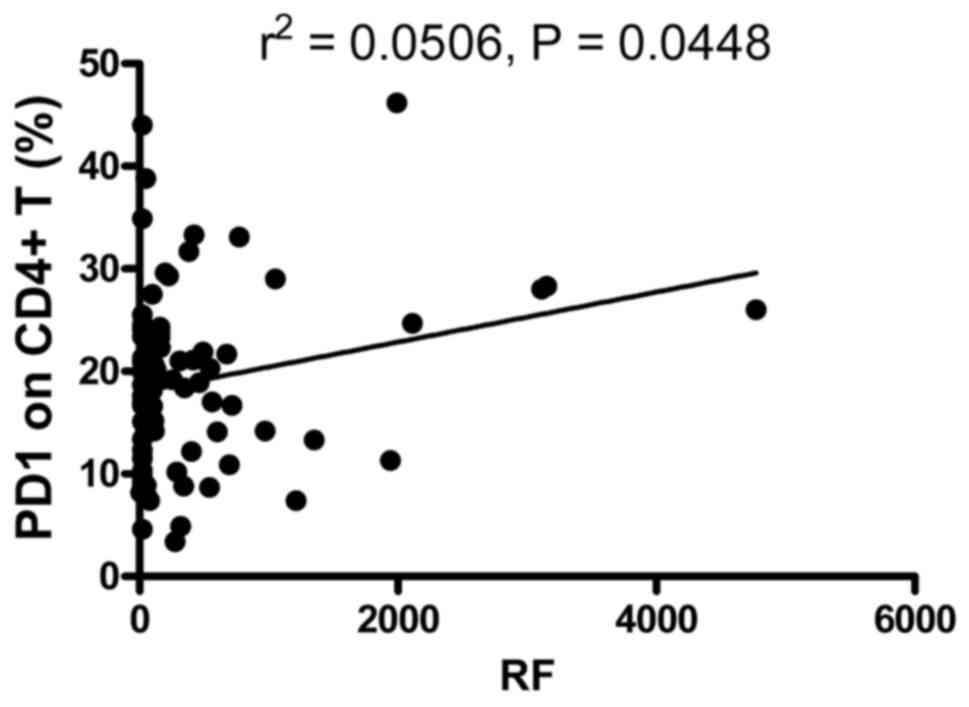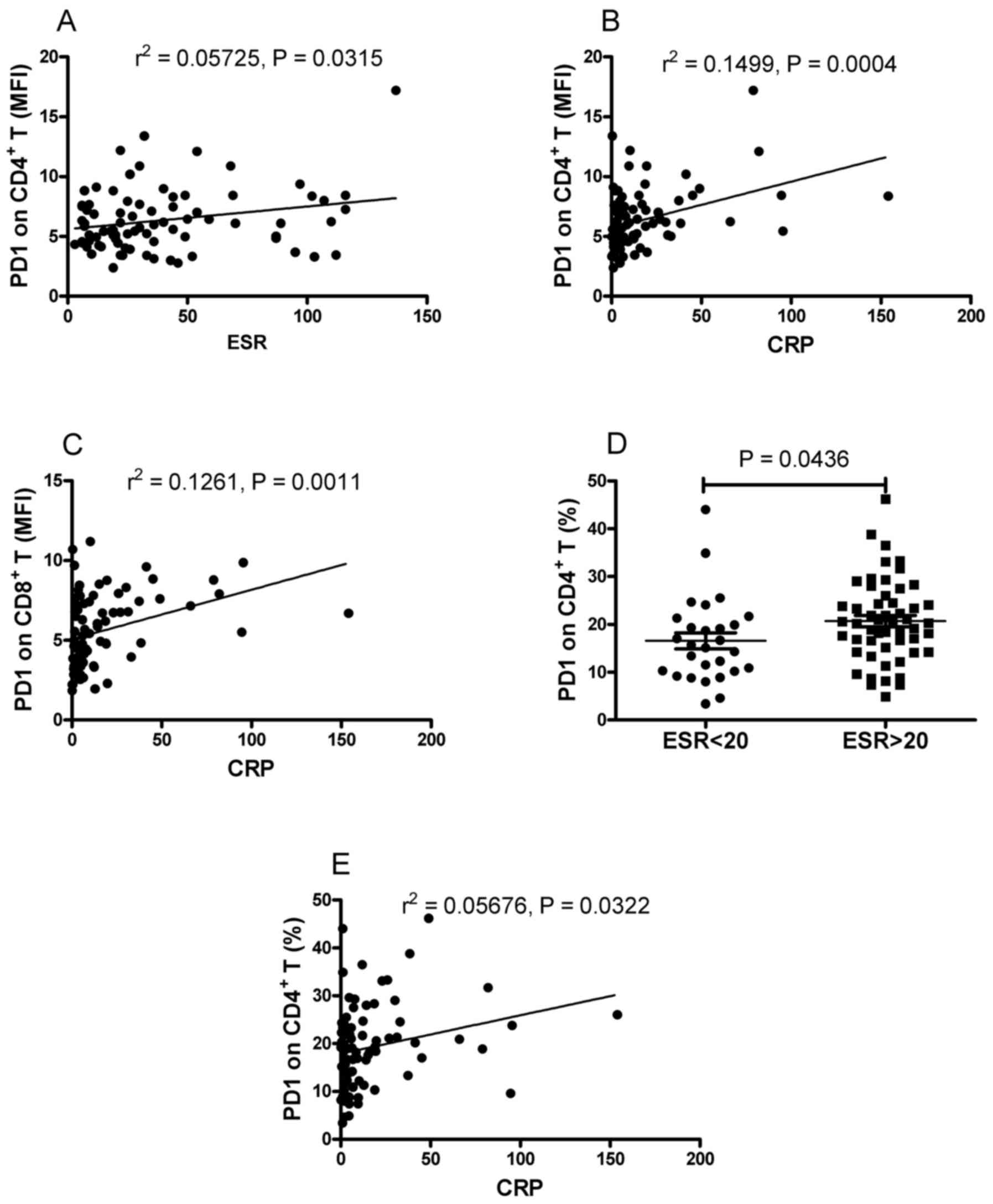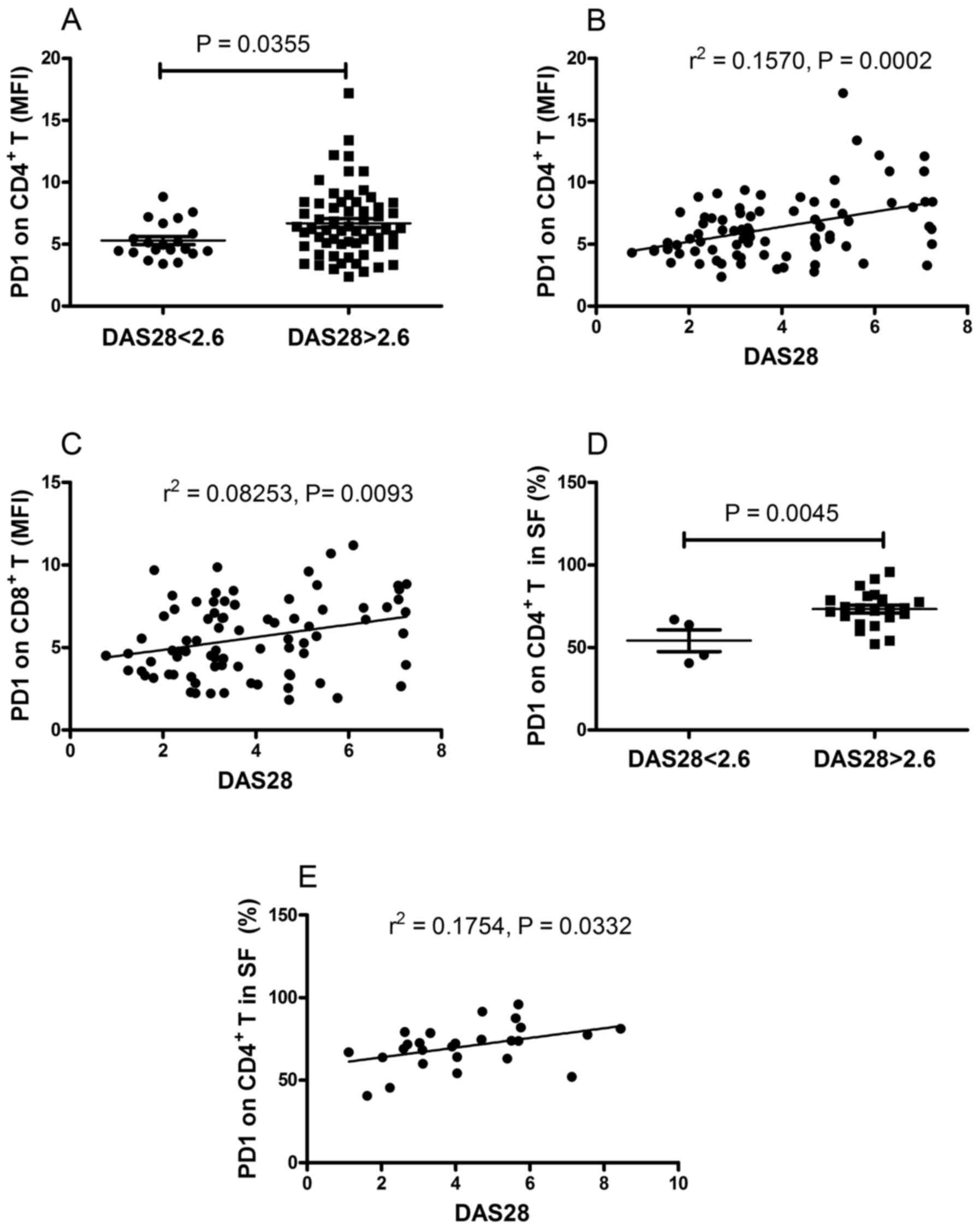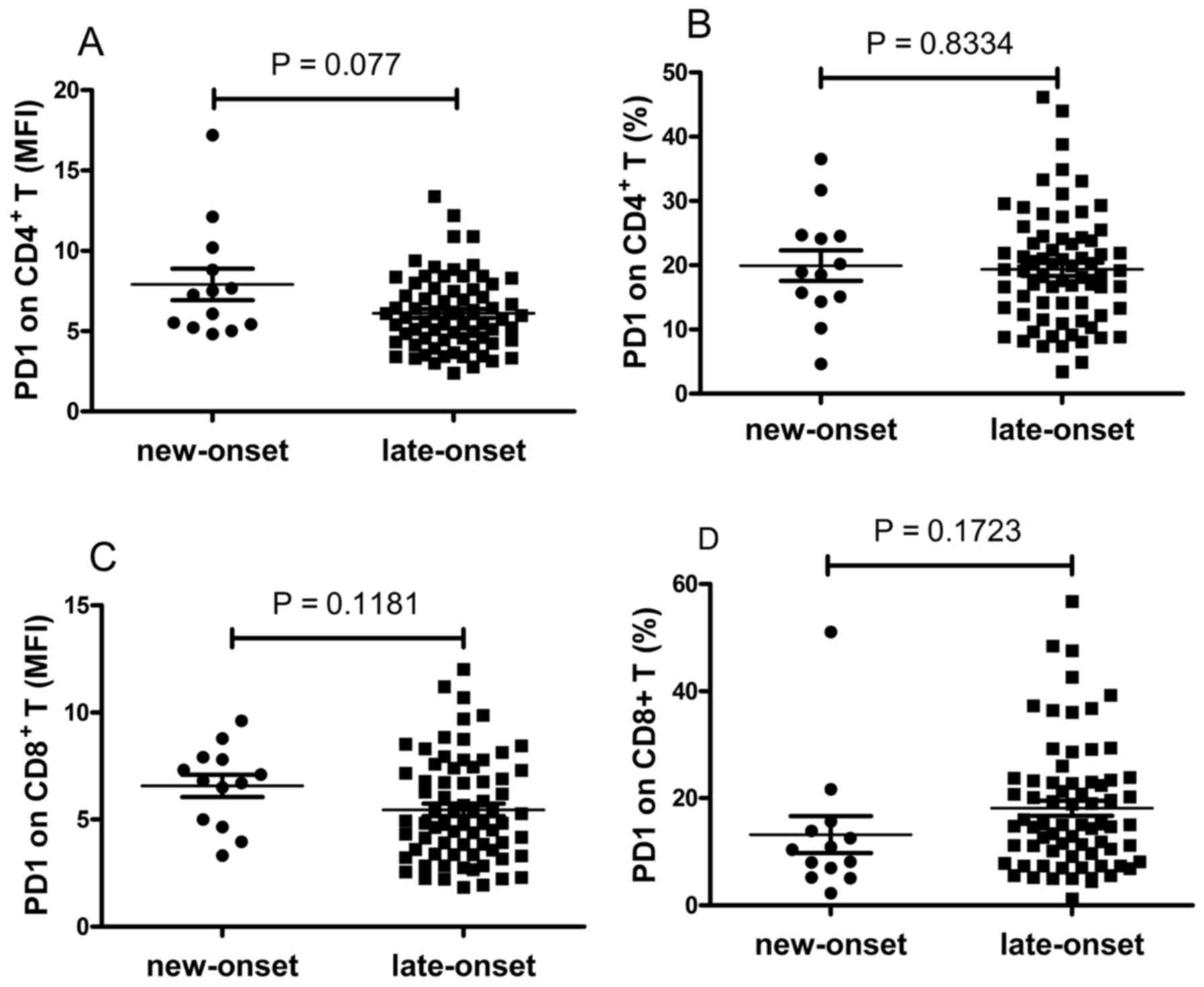Elevated expression of PD‑1 on T cells correlates with disease activity in rheumatoid arthritis
- Authors:
- Published online on: December 6, 2017 https://doi.org/10.3892/mmr.2017.8204
- Pages: 3297-3305
Abstract
Introduction
Rheumatoid arthritis (RA) is a chronic and debilitating systemic autoimmune disease, characterized by inflammation and the destruction of the joints. It is reported that ~1% of the population suffers from RA worldwide, and a substantial number of patients develop long-term joint damage, severe illness and disability (1). The mechanisms underlying RA are complex, including genetic and environmental factors, and abnormalities of the innate and adaptive immune systems. The activation and recruitment of immune cells, particularly lymphocytes, neutrophils and monocytes, into joints are major characteristics of RA (2).
Several studies have shown that T cells are involved in the pathogenesis of RA at multiple levels (3–5). Pivotal in the pathogenesis of RA is the production of pathogenic autoantibodies, including rheumatoid factor (RF) and anticitrullinated protein antibodies (ACPAs) (6,7). Evidence from human studies and animal models indicate that autoantibody production and the pathogenesis of RA are dependent upon T cells (8–10). Previous studies have demonstrated that T cells with abnormal costimulatory molecules can activate autoantibody-producing B cells (11–13), which suggests that costimulatory molecules are important in the pathogenesis of RA. Therefore, determining abnormalities in costimulatory molecule expression on immune cells is crucial for understanding the mechanisms of RA (14–18).
Costimulatory molecules regulate the functional outcome of T cell activation, and disturbance of the balance between activating and inhibitory signals results in increased susceptibility to the induction of autoimmunity. Programmed cell death-1 (PD-1) is a 55-kDa transmembrane protein with 24% amino acid homology to cytotoxic T lymphocyte antigen 4, a member of the CD28 family (19,20). Upon binding with its physical ligand, programmed death ligand 1 (PD-L1), PD-1 transmits an inhibitory signal, which suppresses the activation and proliferation of these PD-1-expressing cells, and protects tissues from inflammatory or autoimmune attack (21).
Studies have shown that the PD-1 may be involved in the pathogenesis of RA, however, this remain controversial (14,22–24). In the present study, the effect of PD-1 on RA was investigated by comparing the expression of PD-1 on CD4+ T cells and CD8+ T cells in the peripheral blood (PB) between patients with RA and healthy controls. In addition, the expression levels of PD-1 on CD4+ T cells and CD8+ T cells were determined in the synovial fluid (SF) of patients with RA. The correlation between PD-1 and the disease activity score 28 (DAS28) of the patients was also evaluated.
Subjects and methods
Subjects
Fresh PB was harvested by venipuncture from 81 patients with RA who fulfilled the American College of Rheumatology criteria for RA (25), and from 30 healthy controls (HCs). Controls and RA patients were recruited from The First Affiliated Hospital of Nanchang University (Nanchang, China) from July 2015 to May 2016 The controls who were unrelated to the patients and had no inflammatory or autoimmune diseases. Among the RA patients, from the time at which the patient complained of joint pain to the time of sample collection, a duration of <6 months was defined as new onset rheumatoid arthritis. SF was obtained from 33 of the 81 patients with RA. The RA disease activity was measured using the DAS28 system (26). Patient details are exhibited in Table I. The present study was approved by the Ethics Committee of the First Affiliated Hospital of Nanchang University and Jiujiang First People's Hospital (019; Jiujiang, China), and was performed in compliance with the Helsinki Declaration. Informed consent was obtained from all participants prior to commencement of the study.
Flow cytometric analysis
The PB and SF samples were collected and analyzed immediately to determine the molecular phenotypes of T lymphocytes using flow cytometry. Prior to flow cytometry, the SF samples were washed twice with D-HANKs. The following antibodies were used: ECD-conjugated anti-CD3, PC5-conjugated anti-CD8, FITC-conjugated anti-CD4 (Beckman Coulter, Inc., Brea, CA, USA), PE-conjugated anti-PD1, and FITC-conjugated anti-PD1 (MIH clones; eBioscience, San Diego, CA, USA). Briefly, 50 µl fresh, heparinized whole blood were incubated simultaneously with 5 µl ECD-conjugated anti-CD3 (cat. no. IM2705U; undiluted), FITC-conjugated anti-CD4 (cat. no. IM0448U; undiluted), 5 µl PC5-conjugated anti-CD8 (cat. no. IM2638U; undiluted) and 5 µl PE-conjugated anti-PD1 (cat. no. 85-12-2799-42; undiluted) on ice in the dark for 30 min at room temperature. Cells incubated with PE-conjugated mouse IgG (cat. no. IM0670U; undiluted) were used as isotype controls. The red blood cells were lysed with ammonium-chloride-potassium lysing buffer. The lymphocytes were gated by forward scatter/side scatter, and the T cell subsets were differentiated by CD3+ staining in lymphocytes, following which CD4+ T cells were identified based on CD4+ staining in T cells. The CD8+ T cells were identified by CD8+ staining in T cells. The samples were analyzed on a CYTOMICS FC 500 flow cytometer (Beckman Coulter, Inc.) and associated software programs (CXP 2.0).
Measurement of erythrocyte sedimentation rate (ESR), C-reactive protein (CRP) and autoantibodies
The ESR was determined according to the manufacturer's instructions. CRP and RF were measured using nephelometry with the IMMAGE 800 system (Beckman Coulter, Inc.). The ACPAs of IgG in the serum were measured using commercially available ELISA kits (Shanghai Kexin Biotech Co., Ltd., Shanghai, China).
Statistical analysis
Statistical analysis and graphic presentation were performed using GraphPad Prism, version 5.0 (GraphPad Software, Inc., La Jolla, CA, USA). A Student's t-test was used for normally distributed data; otherwise, the non-parametric Mann-Whitney test was used to analyze the data. For evaluation of changes between the PB and SF in the same patients, paired t-tests were performed. Pearson's test was used for correlation analysis. P<0.05 was considered to indicate a statistically significant difference.
Results
Characteristics of study subjects
The characteristics of the patients with RA and HCs enrolled in the present study are listed in Table I. No significant differences were observed between the patients and HCs in terms of age or sex. The patients with RA were classified into a remission group (DAS28 <2.6) and active group (DAS28 >2.6) according to the DAS28 system (26). Overall, 74.1% of the patients with RA were in the active group. Among these, 13 cases were classified as new-onset RA (<6 months of disease duration) (13). According to the degree of disease activity, all patients received therapy with one of or more disease-modifying antirheumatic drugs (DMARDs), including hydroxychloroquine, sulphasalazine, methotrexate and leflunomide.
Expression of PD-1 on CD4+ and CD8+ T cells is elevated in patients with RA
To understand the effect of PD-1 on RA, flow cytometry was used to assess the expression of PD-1 on T cells, including CD4+ and CD8+ T cells in the PB. The resulting data showed that the frequency of PD-1-expressing CD4+ T cells and the mean fluorescence intensity (MFI) of PD-1 on CD4+ T cells were significantly elevated in patients with RA, compared with those in the HCs (P<0.05; Fig. 1A and B). The MFI of PD-1 on CD8+ T cells were significantly elevated in patients with RA, compared with HCs (P=0.0078; Fig. 1C). No significant differences were observed in the frequency of PD-1-expressing CD8+ T cells between the RA and HC groups (P=0.096; Fig. 1D). In addition, the frequency of PD-1-expressing CD4+ T cells and the MFI of PD-1 on CD4+ T cells were significantly elevated, compared with CD8+ T cells in the PB of patients with RA (P<0.05; Fig. 1E and F), whereas no statistically significant differences were found between the expression of PD-1 on CD4+ T cells and CD8+ T cells in the PB of the HCs (data not shown).
Lymphocytes can be activated and recruited into joints, and studies have reported that changes in the SF may reflect the development and progression of RA more directly and clearly (27,28). Therefore, the present study investigated the expression of PD-1 on CD4+ and CD8+ T cells in the SF of patients with RA. As shown in Fig. 1A and B, the frequency of PD-1-expressing CD4+ T cells and the MFI of PD-1 on CD4+ T cells in the SF were significantly increased, compared with those in the PB of patients with RA (P<0.0001). The frequency of PD-1-expressing CD8+ T cells in the SF was significantly increased, compared with that in the PB of the patients with RA (P<0.0001; Fig. 1D). No significant difference was observed in the MFI of PD-1 on CD8+ T cells between the SF and PB of the patients with RA (P=0.7942; Fig. 1C). It was also found that the MFI of PD-1 on CD4+ T cells was significantly elevated, compared with that of CD8+ T cells in the SF of patients with RA (P<0.0001; Fig. 1G). However, no statistically significant difference was found between the frequency of PD-1-expressing CD4+ and CD8+ T cells in the SF of the patients with RA (P=0.6172; Fig. 1H). The expression of PD-1 was also compared between the PB and SF from the same patients. It was found that the frequency of PD-1-expressing CD4+ T cells and the MFI of PD-1 on CD4+ T cells were significantly increased in the SF, compared with those in the PB (P<0.0001; Fig. 2A and B). Similarly, the frequency of PD-1-expressing CD8+ T cells and the MFI of PD-1 on CD8+ T cells in SF was significantly higher, compared with those in the PB (P<0.01; Fig. 2C and D). These data suggested that the expression of PD-1 was upregulated in the local environments of RA.
Expression of PD-1 on T cells is correlated with markers of the autoimmune response
RA is characterized by the overproduction of auto-antibodies, including RF and ACPA. Therefore, the hallmark antibodies of RA, RF and ACPA, were determined and analyzed in the present study for their correlation with the expression of PD-1 on CD4+ T and CD8+ T cells. The data showed that 62 patients were positive for RF and 60 patients were positive for ACPA in the patients who received auto-antibody detection. As shown in Fig. 3, the frequency of PD-1-expressing CD4+ T cells was positively correlated with RF (r2=0.0506; P=0.0448). However, the frequency of PD-1-expressing CD8+ T cells, and the MFI of PD-1 on CD4+ T and CD8+ T cells were not correlated with RF (data not shown). The expression levels of PD-1 on CD4+ T and CD8+ T cells were elevated in the patients with positive ACPA, however, this was not a significant difference (data not shown). The correlations between the expression of PD-1 on CD4+ T and CD8+ T cells in the SF and the hallmark antibodies in the serum of RA, were investigated, however, no correlation was found (data not shown). These results showed that the elevated frequency of PD-1-expressing CD4+ T cells was correlated with markers of the autoimmune response, suggesting that the expression of PD-1 on CD4+ T cells may be associated with the pathogenesis of RA.
Correlation between the expression of PD-1 on T cells and markers of inflammation
RA is characterized by synovial hyperplasia and inflammation. Patients with RA are frequently found to have elevated levels of inflammatory markers. In order to investigate the correlation between the expression of PD-1 on T cells and inflammatory markers, the present study analyzed the markers of inflammation, ESR and CRP, for their correlation with the expression of PD-1 on CD4+ T and CD8+ T cells in the patients with RA. As shown in Fig. 4A and B, positive correlations were found between the MFI of PD-1 on CD4+ T cells and the ESR and CRP. It was also found that the MFI of PD-1 on CD8+ T cells was positively correlated with CRP (r2=0.1261; P=0.0011; Fig. 4C). However, no significant correlation was found between the MFI of PD-1 on CD8+ T cells and ESR (data not shown). The present study also examined the correlation between the frequency of PD-1-expressing T cells and inflammatory markers in RA. As shown in Fig. 4D, the frequency of PD-1-expressing CD4+ T cells was significantly increased in the patients with elevated ESR, compared with that in patients with normal ESR (P=0.0436). It was also found that the frequency of PD-1-expressing CD4+ T cells was positively correlated with CRP (r2=0.05676, P=0.0322; Fig. 4E). No correlation was found between the frequency of PD-1-expressing CD8+ T cells and ESR or CRP (data not shown). The present study investigated the correlation between the expression of PD-1 on T cells in the SF and inflammatory markers in the serum of patients with RA. No significant correlation was found (data not shown). These results indicated that the expression of PD-1 on T cells was associated with markers of inflammation.
Correlation between the expression of PD-1 on T cells and with disease activity of RA
The results described above indicated that the expression of PD-1 on T cells was correlated with markers of the autoimmune response and inflammation. A number of these markers, including RF and ACPA, are reported to correlate with disease activity and the severity of joint destruction in RA (29). ESR and CRP are valuable for calculating DAS28, a scoring system used for assessing disease severity in patients with RA. Therefore, patients with RA were further classified into active and remission groups according to the DAS28, and were analyzed for their correlation with the expression of PD-1 on T cells and DAS28. The resulting data showed that the MFI of PD-1 on CD4+ T cells in patients with active RA was significantly higher, compared with that in patients in the remission group (P=0.0355; Fig. 5A). Furthermore, it was found that there was a positive correlation between the DAS28 score and the MFI of PD-1 on CD4+ T cells (r2=0.1570, P=0.0002; Fig. 5B) and the MFI of PD-1 on CD8+ T cells (r2=0.08253, P=0.0093; Fig. 5C). The present study also investigated the correlation between the frequency of PD-1-expressing T cells and DAS28, however, no significant correlation was found (data not shown). The correlation between the expression of PD-1 on T cells in the SF and DAS28 was also examined. As shown in Fig. 5D, the frequency of PD-1-expressing CD4+ T cells in patients with active RA was significantly higher, compared with that in patients in the remission group (P=0.0045). Furthermore, a positive correlation was found between the frequency of PD-1-expressing CD4+ T cells and DAS28 (r2=0.1754, P=0.0332; Fig. 5E). No correlations were found between DAS28 and the MFI of PD-1 on CD4+ T cells, the MFI of PD-1 on CD8+ T cells, or the frequency of PD-1-expressing CD8+ T cells (data not shown). These results demonstrated that the expression of PD-1 on T cells correlated with the disease activity of RA.
The expression levels of PD-1 on T cells were also compared between the patients with new-onset and late-onset RA. The data revealed that the expression of PD-1 on T cells was elevated in patients with new-onset RA, however, this was not significant (P>0.05; Fig. 6A-D).
Discussion
RA is a chronic debilitating systemic autoimmune disease with unclear etiology. In the 2010 American College of Rheumatology/European League Against Rheumatism classification criteria (30), the ACPA, RF, CRP and ESR are used to diagnose RA. However, these biomarkers show weak correlation with disease activity in RA. Therefore, novel biomarkers with improved correlation with the disease activity of RA are required for the evaluation of curative effects or disease development. It is well known that the expression of costimulatory molecules is important in determining the activation status and function of immune cells. Certain costimulatory molecules, particularly immunosuppressive costimulatory molecules, including PD1, PD-L1, T cell immunoglobulin and mucin domain-containing molecule-3 (Tim-3) and T cell immunoreceptor with Ig and immunoreceptor tyrosine-based inhibitory domains (TIGIT), have been reported to be abnormally expressed on T cells, monocytes or natural killer cells in patients with RA (14–18). Several studies have investigated the role of the PD-1/PD-L1 pathway in human studies and animal models of RA. Studies have shown that PD-1+ T cells are enriched in patients with RA (14,22,23), although another study reported conflicting results in which the expression of PD-1 on T cells was significantly decreased in patients with RA (24). The present study investigated the expression of PD-1 on CD4+ and CD8+ T cells in patients with RA, and it was shown that the expression of PD-1 on T cells was significantly increased in patients with RA, compared with that in the healthy individuals. In addition, the expression levels of PD-1 on CD4+ and CD8+ T cells were examined in the SF of patients with RA. It was shown that the expression of PD-1 on T cells in the SF was significantly increased, compared with the expression in the PB of the patients with RA or the healthy controls. The present study also revealed that the expression of PD-1 on T cells was associated with the disease activity of RA.
Lymphocytes are reported to be important in the development and progression of RA (9,10). In accordance with a previous study (23), the present study found that PD-1 was expressed at a higher level on CD4+ T cell than on CD8+ T cells in the PB and SF of patients with RA. The expression levels of PD-1 on CD4+ T and CD8+ T cells were significantly elevated in patients with RA, compared with those in the healthy controls. Generally, the binding of PD-L1 to PD-1 transmits an inhibitory signal, which reduces the proliferation of PD-1-expressing cells. Therefore, as with a previous study (23), the results of the present study suggested that CD4+ helper T cells are the predominant targets of the PD-L1/PD-1 pathway. In addition, the expression levels of PD-1 on CD4+ T and CD8+ T cells in the SF were significantly increased compared with those in the PB of patients with RA or healthy controls. This supports observations that the abnormal expression of key signaling molecules on T lymphocytes is important in the pathogenesis of RA (31,32).
PD-1 is reported to be involved in interactions between T cells and follicular dendritic cells to regulate B cell responses and promote antibody production (8,33,34). It is well known that RA is s systemic autoimmune disease characterized by elevated autoimmune antibodies, including RF and ACPA. In the present study, the serous levels of RF and ACPA were determined and analyzed to examine their association with the expression of PD-1 on T cells. The data revealed that the frequency of PD-1-expressing CD4+ T cells was positively correlated with RF in the serum of patients with RA, suggesting that PD-1-expressing CD4+ T cells may be associated with autoimmune responses in RA. However, although increased in patients with positive ACPA, the correlation between the expression of PD-1 on T cells and ACPA titer was not statistically significant. As the ACPA titer often correlates positively with disease activity and the severity of joint destruction, and is decreased following therapy with DMARDs, the poor correlation between the expression of PD-1 on T cells and ACPA may be due to the fact that the majority of patients with RA had received therapy prior to involvement in the present study.
It is known that the autoimmune response is a type of chronic inflammation against autoantigens. Therefore, the correlations between the expression of PD-1 on T cells and inflammatory markers were analyzed in the present study. The results showed that the expression of PD-1 on T cells was positively correlated with ESR and CRP. Considering ESR and CRP are used for calculating the DAS28, the present study investigated the correlation between the expression of PD-1 on T cells and DAS28, and the results of the DAS28 scores of patients with RA were concordant.
The present study also found that the expression levels of PD-1 on T cells from the PB and SF of RA were upregulated. In addition, the elevated expression of PD-1 on T cells from the PB correlated with RF titer, inflammatory markers and the disease activity of RA. However, the elevated expression of PD-1 on T cells from the SF was not associated with RF titer or the inflammatory markers of RA. It may be that the PB indicates the systemic environment and the SF indicates the local environment in RA.
PD-1 is an inhibitory costimulatory molecule, which mediates inhibitory signals in immune cells (14). Consistent with its inhibitory characteristics, the expression of PD-1 on T cells is decreased in patients with RA, and negatively correlated with RA disease activity (24). Evidence from animal models has shown that PD-1−/− mice exhibit increased incidence and severity of collagen-induced arthritis (14). This suggests the increased expression of PD-1 on T cells in RA appears controversial to its function. However, there is also evidence suggesting that PD-1 may be involved in regulating B cell responses and promoting antibody production (33,34), which is consistent with the observation that the levels of RA specific autoantibody, including RF, were positively correlated with the frequency of PD-1-expressing T cells. Therefore, in addition to its function as an inhibitory costimulatory molecule, PD-1 may have other effects in RA. Future investigations are required to clarify the roles and mechanisms of PD-1-expressing T lymphocytes in the condition of RA.
The present study had a number of limitations. For example, the design of the study included a relatively small sample size, and the PD-1 examined may have been affected by medications and severe disease states. Therefore, certain critical values may result from the small sample size (SF). Future investigations with a larger sample size and using additional techniques may be required to validate the results of this preliminary study.
In conclusion, the present study demonstrated that the expression of PD-1 was upregulated on CD4+ T and CD8+ T cells in RA systemically (PB) and locally (SF). The results of the present study also established a correlation between the expression of PD-1 on T cells and the disease activity of RA, which may improve our understanding of the role of PD-1 in the pathogenesis of RA.
Acknowledgements
The present study was supported by the National Natural Science Foundation of China (grant no. 81360459) and the Jiangxi Provincial Natural Science Foundation of China (grant no. 20151BAB215031). The authors would like to acknowledge the assistance of Dr Rui Wu of the Department of Rheumatology, The First Affiliated Hospital of Nanchang University.
Glossary
Abbreviations
Abbreviations:
|
RA |
rheumatoid arthritis |
|
RF |
rheumatoid factor |
|
anti-CCP |
antibodies against cyclic citrullinated peptides |
|
PD-1 |
programmed cell death 1 |
|
PD-L1 |
programmed death ligand 1 |
|
SF |
synovial fluid |
|
PB |
peripheral blood |
|
DAS28 |
disease activity score 28 |
|
HCs |
healthy controls |
|
ESR |
erythrocyte sedimentation rate |
|
CRP |
C-reactive protein |
|
ACPAs |
anticitrullinated protein antibodies |
|
DMARDs |
disease modifying antirheumatic drugs |
|
MFI |
mean fluorescence intensity |
|
TIGIT |
T cell immunoreceptor with Ig and immunoreceptor tyrosine-based inhibitory domains |
References
|
Goekoop-Ruiterman YP and Huizinga TW: Rheumatoid arthritis: Can we achieve true drug-free remission in patients with RA? Nat Rev Rheumatol. 6:68–70. 2010. View Article : Google Scholar : PubMed/NCBI | |
|
McInnes IB and Schett G: The pathogenesis of rheumatoid arthritis. N Engl J Med. 365:2205–2219. 2011. View Article : Google Scholar : PubMed/NCBI | |
|
Gravallese EM, Manning C, Tsay A, Naito A, Pan C, Amento E and Goldring SR: Synovial tissue in rheumatoid arthritis is a source of osteoclast differentiation factor. Arthritis Rheum. 43:250–258. 2000. View Article : Google Scholar : PubMed/NCBI | |
|
Shigeyama Y, Pap T, Kunzler P, Simmen BR, Gay RE and Gay S: Expression of osteoclast differentiation factor in rheumatoid arthritis. Arthritis Rheum. 43:2523–2530. 2000. View Article : Google Scholar : PubMed/NCBI | |
|
Gracie JA, Forsey RJ, Chan WL, Gilmour A, Leung BP, Greer MR, Kennedy K, Carter R, Wei XQ, Xu D, et al: A proinflammatory role for IL-18 in rheumatoid arthritis. J Clin Invest. 104:1393–1401. 1999. View Article : Google Scholar : PubMed/NCBI | |
|
Rech J, Hueber AJ, Finzel S, Englbrecht M, Haschka J, Manger B, Kleyer A, Reiser M, Cobra JF, Figueiredo C, et al: Prediction of disease relapses by multibiomarker disease activity and autoantibody status in patients with rheumatoid arthritis on tapering DMARD treatment. Ann Rheum Dis. 75:1637–1644. 2016. View Article : Google Scholar : PubMed/NCBI | |
|
Agrawal S, Misra R and Aggarwal A: Autoantibodies in rheumatoid arthritis: Association with severity of disease in established RA. Clin Rheumatol. 26:201–204. 2007. View Article : Google Scholar : PubMed/NCBI | |
|
He J, Tsai LM, Leong YA, Hu X, Ma CS, Chevalier N, Sun X, Vandenberg K, Rockman S, Ding Y, et al: Circulating precursor CCR7(lo)PD-1(hi) CXCR5+ CD4+ T cells indicate Tfh cell activity and promote antibody responses upon antigen reexposure. Immunity. 39:770–781. 2013. View Article : Google Scholar : PubMed/NCBI | |
|
Bennett JC: The role of T lymphocytes in rheumatoid arthritis and other autoimmune diseases. Arthritis Rheum. 58 Suppl 2:S53–S57. 2008. View Article : Google Scholar : PubMed/NCBI | |
|
Holmdahl R, Klareskog L, Rubin K, Björk J, Smedegård G, Jonsson R and Andersson M: Role of T lymphocytes in murine collagen induced arthritis. Agents Actions. 19:295–305. 1986. View Article : Google Scholar : PubMed/NCBI | |
|
Godefroy E, Zhong H, Pham P, Friedman D and Yazdanbakhsh K: TIGIT-positive circulating follicular helper T cells display robust B-cell help functions: Potential role in sickle cell alloimmunization. Haematologica. 100:1415–1425. 2015. View Article : Google Scholar : PubMed/NCBI | |
|
Ma J, Zhu C, Ma B, Tian J, Baidoo SE, Mao C, Wu W, Chen J, Tong J, Yang M, et al: Increased frequency of circulating follicular helper T cells in patients with rheumatoid arthritis. Clin Dev Immunol. 2012:8274802012. View Article : Google Scholar : PubMed/NCBI | |
|
Wang J, Shan Y, Jiang Z, Feng J, Li C, Ma L and Jiang Y: High frequencies of activated B cells and T follicular helper cells are correlated with disease activity in patients with new-onset rheumatoid arthritis. Clin Exp Immunol. 174:212–220. 2013.PubMed/NCBI | |
|
Raptopoulou AP, Bertsias G, Makrygiannakis D, Verginis P, Kritikos I, Tzardi M, Klareskog L, Catrina AI, Sidiropoulos P and Boumpas DT: The programmed death 1/programmed death ligand 1 inhibitory pathway is up-regulated in rheumatoid synovium and regulates peripheral T cell responses in human and murine arthritis. Arthritis Rheum. 62:1870–1880. 2010.PubMed/NCBI | |
|
Moret FM, van der Wurff-Jacobs KM, Bijlsma JW, Lafeber FP and van Roon JA: Synovial T cell hyporesponsiveness to myeloid dendritic cells is reversed by preventing PD-1/PD-L1 interactions. Arthritis Res Ther. 16:4972014. View Article : Google Scholar : PubMed/NCBI | |
|
Li S, Peng D, He Y, Zhang H, Sun H, Shan S, Song Y, Zhang S, Xiao H, Song H and Zhang M: Expression of TIM-3 on CD4+ and CD8+ T cells in the peripheral blood and synovial fluid of rheumatoid arthritis. APMIS. 122:899–904. 2014. View Article : Google Scholar : PubMed/NCBI | |
|
Wang F, Hou H, Wu S, Tang Q, Liu W, Huang M, Yin B, Huang J, Mao L, Lu Y and Sun Z: TIGIT expression levels on human NK cells correlate with functional heterogeneity among healthy individuals. Eur J Immunol. 45:2886–2897. 2015. View Article : Google Scholar : PubMed/NCBI | |
|
Flores-Borja F, Jury EC, Mauri C and Ehrenstein MR: Defects in CTLA-4 are associated with abnormal regulatory T cell function in rheumatoid arthritis. Proc Natl Acad Sci USA. 105:pp. 19396–19401. 2008; View Article : Google Scholar : PubMed/NCBI | |
|
Latchman Y, Wood CR, Chernova T, Chaudhary D, Borde M, Chernova I, Iwai Y, Long AJ, Brown JA, Nunes R, et al: PD-L2 is a second ligand for PD-1 and inhibits T cell activation. Nat Immunol. 2:261–268. 2001. View Article : Google Scholar : PubMed/NCBI | |
|
Nishimura H, Okazaki T, Tanaka Y, Nakatani K, Hara M, Matsumori A, Sasayama S, Mizoguchi A, Hiai H, Minato N and Honjo T: Autoimmune dilated cardiomyopathy in PD-1 receptor-deficient mice. Science. 291:319–322. 2001. View Article : Google Scholar : PubMed/NCBI | |
|
Dai S, Jia R, Zhang X, Fang Q and Huang L: The PD-1/PD-Ls pathway and autoimmune diseases. Cell Immunol. 290:72–79. 2014. View Article : Google Scholar : PubMed/NCBI | |
|
Wan B, Nie H, Liu A, Feng G, He D, Xu R, Zhang Q, Dong C and Zhang JZ: Aberrant regulation of synovial T cell activation by soluble costimulatory molecules in rheumatoid arthritis. J Immunol. 177:8844–8850. 2006. View Article : Google Scholar : PubMed/NCBI | |
|
Hatachi S, Iwai Y, Kawano S, Morinobu S, Kobayashi M, Koshiba M, Saura R, Kurosaka M, Honjo T and Kumagai S: CD4+ PD-1+ T cells accumulate as unique anergic cells in rheumatoid arthritis synovial fluid. J Rheumatol. 30:1410–1419. 2003.PubMed/NCBI | |
|
Li S, Liao W, Chen M, Shan S, Song Y, Zhang S, Song H and Yuan Z: Expression of programmed death-1 (PD-1) on CD4+ and CD8+ T cells in rheumatoid arthritis. Inflammation. 37:116–121. 2014. View Article : Google Scholar : PubMed/NCBI | |
|
Arnett FC, Edworthy SM, Bloch DA, McShane DJ, Fries JF, Cooper NS, Healey LA, Kaplan SR, Liang MH, Luthra HS, et al: The American rheumatism assocaition 1987 revised criteria for the classification of rheumatoid arthritis. Arthr Rhuem. 31:315–324. 1988. View Article : Google Scholar | |
|
Prevoo ML, van't Hof MA, Kuper HH, van Leeuwen MA, van de Putte LB and van Riel PL: Modified disease activity scores that include twenty-eight-joint counts. Development and validation in a prospective longitudinal study of patients with rheumatoid arthritis. Arthritis Rheum. 38:44–48. 1995. View Article : Google Scholar : PubMed/NCBI | |
|
Lajas C, Abasolo L, Bellajdel B, Hernández-García C, Carmona L, Vargas E, Lázaro P and Jover JA: Costs and predictors of costs in rheumatoid arthritis: A prevalence-based study. Arthritis Rheum. 49:64–70. 2003. View Article : Google Scholar : PubMed/NCBI | |
|
Yuan FL, Li X, Lu WG, Li CW, Xu RS and Dong J: IL-33: A promising therapeutic target for rheumatoid arthritis? Expert Opin Ther Targets. 15:529–534. 2011. View Article : Google Scholar : PubMed/NCBI | |
|
Wright HL, Moots RJ and Edwards SW: The multifactorial role of neutrophils in rheumatoid arthritis. Nat Rev Rheumatol. 10:593–601. 2014. View Article : Google Scholar : PubMed/NCBI | |
|
Cohen S and Emery P: The American College of Rheumatology/European League Against Rheumatism Criteria for the classification of rheumatoid arthritis: A game changer. Ann Rheum Dis. 69:1575–1576. 2010. View Article : Google Scholar : PubMed/NCBI | |
|
Carruthers DM, Arrol HP, Bacon PA and Young SP: Dysregulated intracellular Ca2+ stores and Ca2+ signaling in synovial fluid T lymphocytes from patients with chronic inflammatory arthritis. Arthritis Rheum. 43:1257–1265. 2000. View Article : Google Scholar : PubMed/NCBI | |
|
Malemud CJ: Dysfunctional immune-mediated inflammation in rheumatoid arthritis dictates that development of anti-rheumatic disease drugs target multiple intracellular signaling pathways. Antiinflamm Antiallergy Agents Med Chem. 10:78–84. 2011. View Article : Google Scholar : PubMed/NCBI | |
|
Good-Jacobson KL, Szumilas CG, Chen L, Sharpe AH, Tomayko MM and Shlomchik MJ: PD-1 regulates germinal center B cell survival and the formation and affinity of long-lived plasma cells. Nat Immunol. 11:535–542. 2010. View Article : Google Scholar : PubMed/NCBI | |
|
Liu R, Wu Q, Su D, Che N, Chen H, Geng L, Chen J, Chen W, Li X and Sun L: A regulatory effect of IL-21 on T follicular helper-like cell and B cell in rheumatoid arthritis. Arthritis Res Ther. 14:R2552012. View Article : Google Scholar : PubMed/NCBI |



